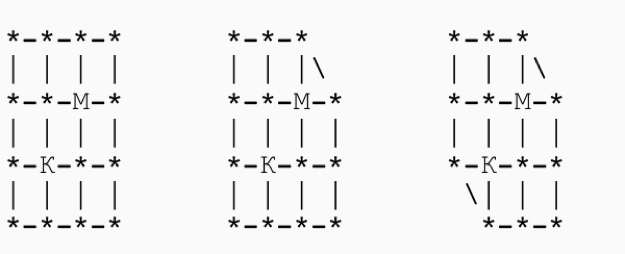Problems
Determine all integer solutions of the equation \(yk = x^2 + x\). Where \(k\) is an integer greater than \(1\).
There are 68 coins, and it is known that any two coins differ in weight. With 100 weighings on a two-scales balance without weights, find the heaviest and lightest coin.
A cat tries to catch a mouse in labyrinths A, B, and C. The cat walks first, beginning with the node marked with the letter “K”. Then the mouse (from the node “M”) moves, then again the cat moves, etc. From any node the cat and mouse go to any adjacent node. If at some point the cat and mouse are in the same node, then the cat eats the mouse.
Can the cat catch the mouse in each of the cases A, B, C?

Two play a game on a chessboard \(8 \times 8\). The player who makes the first move puts a knight on the board. Then they take turns moving it (according to the usual rules), whilst you can not put the knight on a cell which he already visited. The loser is one who has nowhere to go. Who wins with the right strategy – the first player or his partner?
Two players in turn increase a natural number in such a way that at each increase the difference between the new and old values of the number is greater than zero, but less than the old value. The initial value of the number is 2. The winner is the one who can create the number 1987. Who wins with the correct strategy: the first player or his partner?
a) The vertices (corners) in a regular polygon with 10 sides are colored black and white in an alternating fashion (i.e. one vertex is black, the next is white, etc). Two people play the following game. Each player in turn draws a line connecting two vertices of the same color. These lines must not have common vertices (i.e. must not begin or end on the same dot as another line) with the lines already drawn. The winner of the game is the player who made the final move. Which player, the first or the second, would win if the right strategy is used?
b) The same problem, but for a regular polygon with 12 sides.
Prove that in any group of 7 whole numbers – not necessarily consecutive – it is possible to choose three numbers such that their sum is divisible by 3.
What is the minimum number of squares that need to be marked on a chessboard, so that:
1) There are no horizontally, vertically, or diagonally adjacent marked squares.
2) Adding any single new marked square breaks rule 1.
What figure should I put in place of the “?” in the number \(888 \dots 88\,?\,99 \dots 999\) (eights and nines are written 50 times each) so that it is divisible by 7?
We are given 101 rectangles with integer-length sides that do not exceed 100.
Prove that amongst them there will be three rectangles \(A, B, C\), which will fit completely inside one another so that \(A \subset B \subset C\).